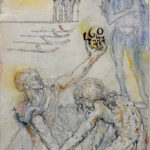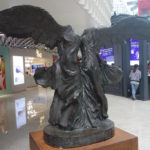By Reed V. Horth, for CBPMag.com and Robin Rile Fine Art
“It used to be called plundering. But today things have become more humane. In spite of that, I intend to plunder, and to do it thoroughly” ~Reichmarshall Hermann Goering, August 6, 1942
Call us Bohemian, if you will. When my wife and I travel, we like to rent apartments in small-local communities, as opposed to luxurious hotels in heavily trafficked areas. This allows us to interact with locals and get to know what it is like to really LIVE in the cities we visit. This approach has allowed us to stumble upon some of the most incredible parties, museums, friendships and sights by just getting out and being part of a community.
One such instance found us perusing the streets of Bruge, Belgium (alternatively spelled Bruges, Brugge, etc.), one of the most beautiful and historic cities in Northern Europe. Kat combed VRBO.com and located a charming 17th Century home called “Lady Lace” in the Ezelstraat quarter, just inside the walled city (http://www.vrbo.com/252617). Among other things, Bruge is known for its lace, of which we would see a varied array adorning the wall of the house during our stay. This three story, 100 SqM, home features the traditional stepped gable façade, oak-beamed ceilings and a small private sun-area in which you can take in one of the other pleasures of Bruge, the beer (in this case couple of Brugse ZOT). It was one of the most beautiful of all the places we have traveled and our accommodations could not have been better.
My art historical background led us to this small Belgian town on a quest not for beer, chocolate or lace though.
We came for the Michelangelo.
Bruges is the only city outside of Italy which features an original marble sculpture from Michelangelo (Michelangelo di Lodovico Buonarroti Simoni – Italian, 6 March 1475 – 18 February 1564) which was exported during the lifetime of the artist… the aptly titled, “Madonna of Bruges” (1501-1504). While I had worked on several projects involving Michelangelo sculpture throughout college and into my professional life, my interest was re-kindled by the “Michelangelo: Man & the Myth” exhibition at Syracuse University in 2008 (http://michelangelo.syr.edu/), of which I was an honored invitee of Professor Dr. Gary Radke, an expert on Renaissance Art. After the exhibition, in my spare time, I would devour tomes about renaissance art and developed a specific fascination with works which had been stolen throughout history. Among them, the story of the “Madonna of Bruges” stood out to me. So much so, that Bruges was placed high on the list of “places to go”.
This work has been shrouded in mystery from the outset. Michelangelo surreptitiously sold the work to the Flemish Mouscron family in 1504, despite it being commissioned for Pope Julius II in Rome. He demanded that it not be placed on public view for fear of repercussions from the Papacy. When it was finally placed in Bruges in 1506, the city, which was an important hub for commerce only a century before, was in steep decline. No one knew of the Italian Michelangelo, as this was the only work which left Italy during the lifetime of the artist. Therefore, residents took little note of the pleasing, yet distinctively un-Flemish Madonna and Child figure. Compositionally similar to his famed “Pietà” at the Vatican, the Bruges Madonna seems the prequel to the earlier Roman version, completed in 1498-1500. Her young face gently glances down to her son and he boldly descends his mother’s knee through flowing and textured draping. Contrasting the Vatican example, the Christ child is a living, breathing being with personality. He is tentative, but confident. Mary’s young face, which is longer and more mournful than the Vatican’s “Pietà”, gazes passively, as if resigned to allow the boy the freedom to make his own way. By the 1600s, Michelangelo was a venerated figure and all Belgians came to know the “Madonna” as an item of tremendous national importance. In 1794, Napoleon demanded the work be shipped to Paris for his personal collection, to be housed in the Louvre. After its return two decades later, Belgium would be hard pressed to relinquish their treasure again.
The “Monuments Men“, an upcoming film starring George Clooney and Matt Damon, (after Robert’s Edsel’s 2009 book) chronicles the tales of the American and British soldiers tasked with protecting cultural patrimony in Europe during World War II. Not only were the soldiers terribly understaffed, they also had difficulty convincing hardened field commanders NOT to destroy buildings, bridges and churches of Europe even if there were enemy troops holed up there, despite General Dwight D. Eisenhower’s decree that they make every reasonable effort not to.
“Shortly we will be fighting our way across the Continent of Europe in battles designed to preserve our civilization. Inevitably, in the path of our advance will be found historical monuments and cultural centers which symbolize to the world all that we are fighting to preserve. It is the responsibility of every commander to protect and respect these symbols whenever possible.” ~Supreme Commander of Allied Expeditionary Forces, Gen. Dwight D. Eisenhower 26 May, 1944.
Eisenhower had learned a hard lesson when Allied troops, after months of slow progress at the city of Montecassino in Italy, bombed the ancient monastery, thinking German troops were based inside. There were no troops inside the abbey at all, only lining the hill beneath. After the bombing, German propaganda highlighted the barbarism of Allied troops to an Italian population who became suitably outraged. The Monuments Men, led by Lieutenant George Stout and 2nd Lieutenant James Rorimer (known as Frank Stokes and James Granger for the purposes of the film- See Film Note below), were tasked with making certain such an incident did not occur again. As they foraged through France and Italy, pushing with Allied advances, they created detailed maps of areas, monuments, museums, churches, graveyards and other buildings of historical and cultural importance which Allied troops were strictly mandated not to desecrate. Attempting to convince troops, some of whom militarily outrank you, not to indulge in destruction for the sake of expedience, ease or simple boredom, is a heavy task indeed. As they moved through the countryside, tales began to emerge of Nazi looting of treasures in each of the cities. Understanding that many of the world’s most important Western artworks, artifacts and treasures were within occupied areas, the Monuments Men adopted the task of attempting to locate the looted art, in addition to their duties to protect the works which had not yet been harmed. Among the treasures most coveted by Nazi leader Adolf Hitler, was the “Madonna of Bruges”.

Housed in the Bruges Cathedral of Notre Dame, the “Madonna” seemed safe from plunder. Until the world exploded. Before daybreak on September 7, 1944, Nazi soldiers rapped against the door of the Cathedral of Notre Dame. “We’re taking the Michelangelo. To protect it from the Americans.” Incredulous, the sacristan had little choice but to allow the heavily armed and determined Nazi soldiers to enter the cathedral. After haphazardly tying the “Madonna” between two mattresses, the heartbroken sacristan watched them load her into the back of a truck emblazoned with the “RED CROSS” logo and drive away into the dawn light.
Contrary to popular belief, Hitler’s “Nero Decree” (19 March, 1945), in which “every opportunity, direct or indirect, to inflict the most lasting possible damage on the enemy’s striking power must be used to the utmost”, was not originally intended to include the destruction of the artwork. It was intended to include supply routes, bridges, communication lines and other items of strategic value. However, several of Hitler’s high command, including Gauleiter August Eigruber (a regional governor for the Nazi party), interpreted the message to include “everything”, including the art under his jurisdiction. Dr. Emmerich Pöchmüller, the civilian general director of the Altaussee mining operation (in which Hitler commandeered salt mines in Austria for the safe storage of artworks till wars end), learned that Eigruber was planning to bomb his mines in accordance with the “Nero Decree” and worked to intervene. On penalty of death for insubordination, Pöchmüller purportedly fabricated a written order from Eigruber granting himself authority over the disposition of the mine and all its contents and turned it in to his chief of staff. If is deception was discovered, this order would be Pöchmüller’s own death warrant.
On 16 May, 1945, Monuments Men, Capt. Robert Posey & Pvt. 1st class Lincoln Kirstein walked a quarter of a mile down a mineshaft outside the town of Altaussee in central Austria. Their path was abruptly stopped by a massive wall of debris stretching from floor to ceiling.
The mine had been dynamited.
“We do not want to destroy unnecessarily what men spent so much time and care and skill in making… [for] these examples of craftsmanship can tell us so much about our ancestors… If these things are lost or broken or destroyed, we lose a valuable part of our knowledge about our forefathers. No age lives entirely alone; every civilization is formed not merely by its own achievements but by what it has inherited from the past. If these things are destroyed, we have lost a part of our past, and we shall be poorer for it.” ~British Monuments Man Major Ronald Balfour, 1944.
Whether through Pöchmüller’s intervention or other means, it was later discovered through an excavation and witness testimony that the eight bombs Eigruber intended to destroy the mine were removed and the mineshaft was blown in order to paralyze any further attempts to destroy the art safely held within. When Eigruber finally discovered the deception, he “ordered all the Austrians to be shot”. But, with Americans already within striking distance on the other side of the mountain, the orders were never carried out.
Using pick and shovels a narrow crevice opened at the top of the mineshaft, just enough for a single man to squeeze through. Posey and Kirstein crept through blown doors and barred gates, to discover innumerable rows of treasures; from Van Eyck’s Virgin Mary to portions of the miraculous Ghent Altarpiece and everything in between. The mines contained literally tens of thousands of items of irreplaceable cultural, historical and financial importance. After many excited moments, they finally saw, through a torch lit gloom…. The pristine milky white surface of Michelangelo’s “Madonna of Bruges”.

More than 66 years later, she stood before me, glistening in the afternoon light of the Church of Our Lady… At home, in Bruges. Few instances in my life leave me truly speechless. This was one. The confluence of stories from Michelangelo, to the Monuments Men, to Hitler and his minions, all bring history full circle. In 2003, former US Defense Secretary Donald Rumsfeld myopically said “[in war] Stuff happens” in the aftermath of the looting of the Iraqi National Museum. What we discovered on that day, standing before a miracle of human ingenuity, was best was stated by Major Balfour more than 60 years before, “No age lives entirely alone; every civilization is formed not merely by its own achievements but by what it has inherited from the past. If these things are destroyed, we have lost a part of our past, and we shall be poorer for it.”
For this, we owe the Monuments Men a debt of gratitude beyond simply seeing a movie or reading a book. You owe it to them and to yourself to visit Bruge… or the Uffizi, or the Louvre or Neuschwanstein or Altaussee or any of the other major cultural sites which we effectively saved by the ingenuity and vision of men who remembered that art does not live in the past… It provides us a future.
****
- Many of the anecdotes, quotes and scenes are contained within this article are included in “The Monuments Men: Allied Heroes, Nazi Thieves and the Greatest Treasure Hunt in History” by Robert M. Edsel. See http://www.monumentsmenfoundation.org/ for more information, and read the book for the full story.
- NOTE: “We knew the characters were interesting. We changed the names, obviously, because we’re not doing a documentary, and we wanted to be able to give these guys flaws. They were real people, and you don’t want to give real people flaws. So we changed the names so we could mess with them a little bit. We want there to be a little humor. We don’t want this to be a civics lesson.” ~George Clooney with Entertainment Weekly, on the name change for the characters as featured in the movie. 12/August, 2013.
Reed V. Horth, is the president, curator and writer for ROBIN RILE FINE ART in Miami, FL. He has been a private dealer, gallerist and blogger since 1996, specializing in 20th century and contemporary masters. www.robinrile.com
All content ©2014 ROBIN RILE FINE ART. Any unauthorized reproduction of images, text or content is strictly prohibited.











